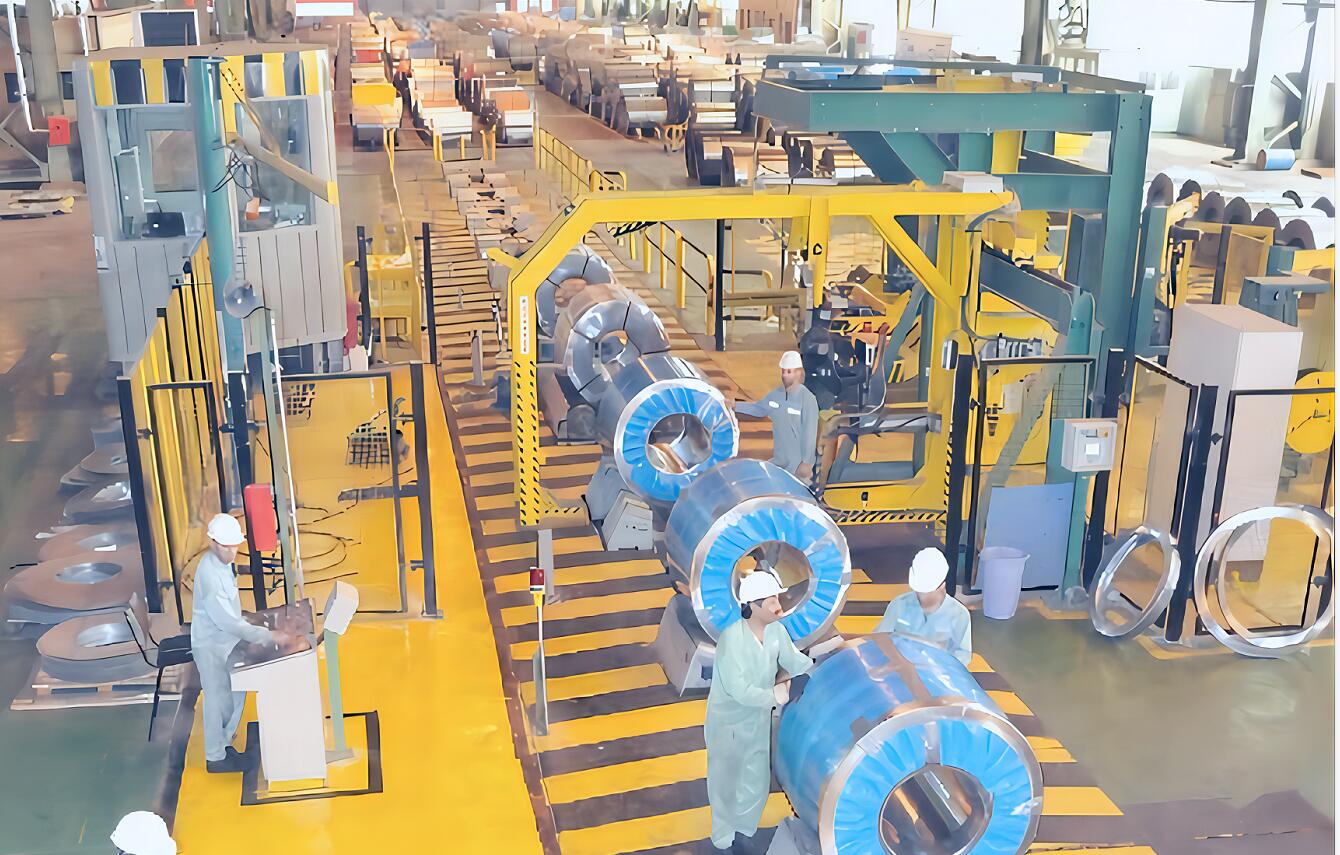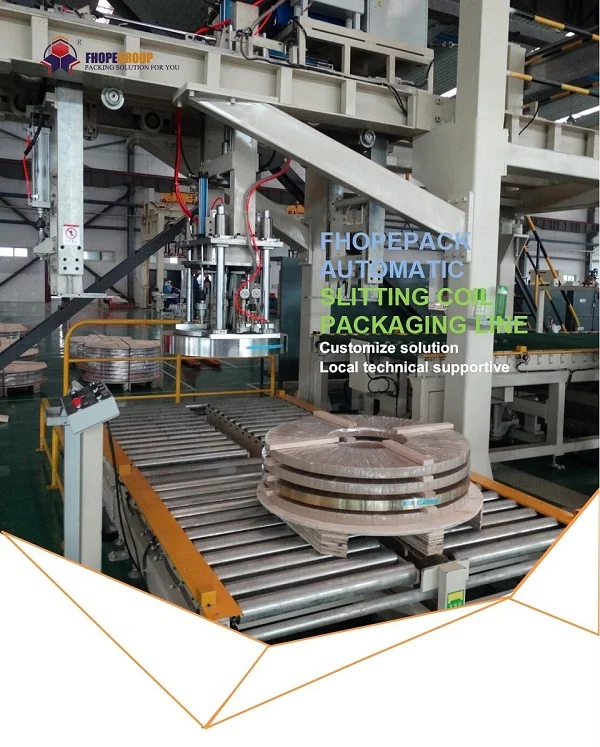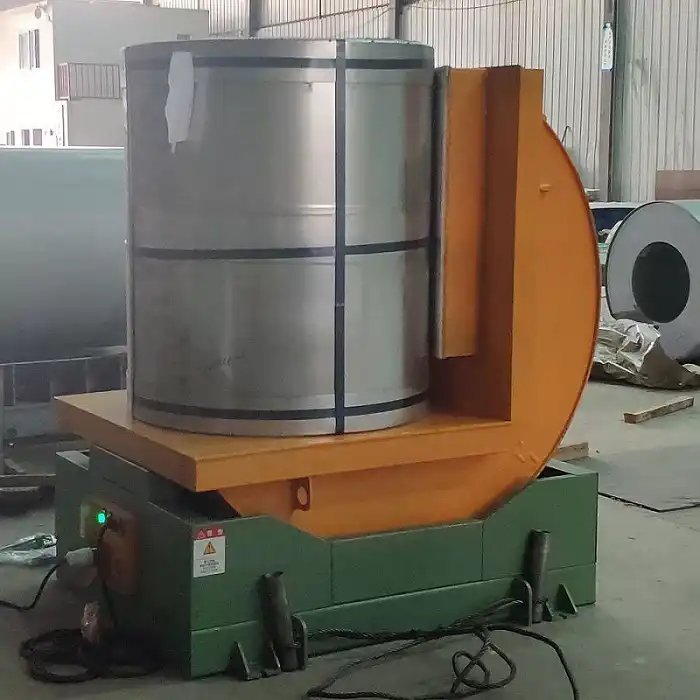How to Prevent Steel Coil Edge Damage During Automated Wrapping?
Are you tired of steel coils arriving with bent edges, costing you time and money? Edge damage during automated wrapping is a common headache in the metal fabrication industry, but it doesn’t have to be. Discover proven strategies to safeguard your coils and streamline your operations.
Preventing steel coil edge damage during automated wrapping involves several key steps: proper coil alignment and centering before wrapping, utilizing edge protection materials like angle boards or V-shaped protectors, adjusting wrapping tension and overlap settings on automated machines, and regular inspection of equipment for wear or misalignment. Implementing these best practices can significantly reduce damage and improve coil quality.
Edge damage not only diminishes the aesthetic appeal of your steel coils but also compromises their structural integrity and usability. Let’s delve into the critical areas you need to focus on to minimize these costly damages and ensure your automated wrapping process is as efficient and protective as possible.
Understanding the Common Causes of Edge Damage During Automated Wrapping
Steel coil edge damage during automated wrapping isn’t just bad luck; it’s often the result of identifiable issues in the wrapping process. Recognizing these root causes is the first step to effective prevention. Are you aware of the subtle factors that might be causing unseen damage to your valuable coils?
Several factors contribute to steel coil edge damage during automated wrapping. Misalignment of the coil on the wrapping platform, excessive wrapping tension, inadequate or improper use of edge protection, and worn or poorly maintained wrapping machinery are primary culprits. Additionally, inconsistencies in coil dimensions or shape can exacerbate these issues, leading to increased vulnerability to edge damage. Addressing each of these areas systematically is crucial for minimizing losses and ensuring product integrity.

Dive Deeper into Damage Mechanisms
To truly combat edge damage, we must understand the mechanics behind it. It’s not enough to just know what causes damage; knowing how it happens allows for more targeted and effective preventative measures. Let’s break down the common damage mechanisms:
1. Misalignment and Off-Centering
When a steel coil isn’t perfectly centered on the wrapping platform, or if it’s misaligned as it begins to rotate, uneven pressure distribution occurs during wrapping. This concentrated pressure on the edges, especially if they protrude slightly, can lead to bending, crimping, or even tearing of the edge.
2. Excessive Wrapping Tension
Automated wrapping machines apply tension to the wrapping film to secure the coil. However, if the tension is set too high, particularly at the start and end of the wrapping cycle where the film is anchored and cut, the edges can be crushed or deformed. This is especially problematic for thinner gauge coils.
3. Inadequate Edge Protection
Edge protectors are designed to distribute wrapping pressure away from the vulnerable coil edges. If the wrong type of edge protection is used, or if it’s improperly applied (e.g., too short, misaligned, or insufficient quantity), the edges remain exposed and susceptible to damage from wrapping pressure and subsequent handling.
4. Machinery Issues
Worn rollers, uneven platform surfaces, or miscalibrated tension controls on automated wrapping machines can all contribute to inconsistent and damaging wrapping forces. Regular maintenance and calibration are essential to ensure the machinery operates within safe and effective parameters.
5. Coil Irregularities
Variations in coil shape (out-of-roundness, telescoping) or dimensional inconsistencies (uneven edges, varying widths) make coils more challenging to wrap uniformly. These irregularities create points of stress concentration where damage is more likely to occur, especially at the edges.
To visualize the impact of these factors, consider the following table outlining common causes and their typical consequences:
| Cause | Mechanism | Typical Edge Damage | Severity |
|---|---|---|---|
| Coil Misalignment | Uneven pressure distribution during wrapping | Bent edges, crimping, telescoping | Moderate to High |
| Excessive Wrapping Tension | Concentrated force on edges | Crushed edges, deformation, film cutting into edges | Moderate to High |
| Insufficient Edge Protection | Direct pressure on unprotected edges | Bending, scratches, dents, corrosion initiation | Low to Moderate |
| Machinery Wear/Miscalibration | Inconsistent wrapping forces | Variable damage patterns, unpredictable edge issues | Moderate to High |
| Coil Irregularities | Stress concentration at weak points | Localized bending, edge tearing, uneven wrapping | Moderate to High |
Understanding these mechanisms allows for a more targeted approach to prevention. It’s not just about "wrapping better"; it’s about addressing the specific vulnerabilities at each stage of the automated wrapping process.
Implementing Effective Edge Protection Strategies
Protecting steel coil edges effectively during automated wrapping isn’t a one-size-fits-all solution. It requires a tailored approach using appropriate materials and techniques. Are you leveraging the right edge protection to safeguard your coils from the pressures of automated wrapping?
Effective edge protection for steel coils during automated wrapping involves selecting and correctly applying protective materials like angle boards, V-boards, or custom-designed edge protectors. These materials distribute wrapping pressure, cushion edges against impacts, and prevent direct contact with abrasive wrapping films. Proper application technique, ensuring full edge coverage and secure placement before wrapping, is equally crucial for optimal protection. Choosing the right materials and methods is key to preventing damage and maintaining coil quality.

Advanced Techniques and Material Choices
Moving beyond basic cardboard protectors, the industry offers a range of advanced solutions designed for the rigors of automated wrapping and demanding transport conditions. Let’s explore some of these enhanced techniques and materials:
1. High-Strength Angle Boards and V-Boards
These are not your standard cardboard corners. Modern angle boards and V-boards are engineered from high-density laminated paperboard or even recycled plastics, offering significantly increased crush resistance and edge protection. They are designed to withstand the high tension of automated wrapping and the stresses of stacking and transportation.
2. Custom-Contoured Edge Protectors
For coils with specific profiles or particularly sensitive edges, custom-designed edge protectors offer a tailored solution. These can be molded from plastics or composite materials to perfectly fit the coil’s circumference, providing maximum contact and pressure distribution. Some designs incorporate cushioning materials like foam or rubber to further absorb impacts.
3. Integrated Edge Protection Systems
Some automated wrapping systems now offer integrated edge protection application features. These systems automatically apply pre-cut edge protectors to the coil before wrapping begins, ensuring consistent placement and reducing manual handling. This automation not only improves protection but also increases wrapping line efficiency.
4. Moisture and Corrosion Resistant Protectors
For coils destined for long-term storage or harsh environments, moisture and corrosion-resistant edge protectors are essential. These protectors are often coated or laminated with water-repellent materials and may incorporate Vapor Corrosion Inhibitors (VCIs) to provide added protection against rust, especially at the edges where moisture tends to accumulate.
5. Reusable and Sustainable Options
In line with increasing sustainability concerns, reusable edge protection systems are gaining traction. These systems, often made from durable plastics or metals, can be returned and reused multiple times, reducing waste and long-term costs. Additionally, choosing edge protectors made from recycled and recyclable materials contributes to a more environmentally responsible operation.
Consider this comparison of edge protection materials:
| Material Type | Strength/Protection Level | Moisture Resistance | Reusability | Cost | Best Use Case |
|---|---|---|---|---|---|
| Standard Cardboard | Low | Low | Single-use | Low | Lightweight coils, minimal handling, dry environments |
| High-Density Paperboard | Medium | Low to Medium | Single-use | Medium | General purpose coils, moderate handling |
| Recycled Plastics | Medium to High | Medium to High | Reusable/Single-use | Medium to High | Heavy coils, demanding transport, moisture exposure |
| Custom Composites | High | High | Reusable | High | High-value coils, extreme conditions, automated lines |
By carefully selecting edge protection materials and techniques, you can create a robust defense against edge damage during automated wrapping, ensuring your steel coils arrive at their destination in pristine condition.
Optimizing Automated Wrapping Machine Settings for Damage Prevention
Automated wrapping machines are powerful tools, but their settings can be a double-edged sword. Incorrect settings can lead to significant edge damage. Are your wrapping machine settings contributing to, or preventing, coil edge damage?
Optimizing automated wrapping machine settings to prevent steel coil edge damage requires careful adjustment of tension controls, overlap percentages, and wrapping cycles. Lowering initial and final wrapping tension, especially at coil edges, setting appropriate film overlap to balance security and pressure, and programming wrapping cycles that start and end smoothly are crucial adjustments. Regular calibration and monitoring of these settings ensure consistent and damage-free wrapping. Fine-tuning your machine is essential to protecting your coils.

Fine-Tuning for Edge Protection
Achieving optimal wrapping performance without compromising coil edges is a delicate balance. It requires a systematic approach to adjusting machine parameters. Let’s explore the key settings and how to fine-tune them for edge damage prevention:
1. Tension Control: Start and Finish Soft
The most critical setting for edge protection is tension control. Excessive tension, particularly at the beginning and end of the wrapping cycle, puts concentrated pressure on the edges. Modern wrapping machines allow for programmable tension profiles.
- Soft Start: Program the machine to start wrapping with minimal tension, gradually increasing to the desired level as the wrap progresses away from the edges.
- Soft Finish: Similarly, reduce tension in the final wraps before the film is cut and sealed. This prevents edge crushing during the sealing process.
2. Overlap Percentage: Balance Security and Pressure
Film overlap ensures a secure and water-resistant wrap. However, excessive overlap, especially when combined with high tension, can create excessive layers of film at the edges, increasing pressure points.
- Optimal Overlap: Aim for an overlap percentage that provides adequate security (typically 30-50%) without excessive buildup at the edges. Experiment to find the sweet spot for your specific film and coil types.
- Layer Distribution: Some advanced machines allow for programmed layer distribution, concentrating more layers on the coil body and fewer at the edges.
3. Wrapping Cycles: Smooth Starts and Stops
Jerky starts and stops of the wrapping cycle can create sudden tension spikes that damage edges.
- Ramp-Up/Ramp-Down: Program smooth acceleration and deceleration curves for the wrapping arm and coil rotation. This ensures gradual tension changes, minimizing stress on the edges.
- Consistent Speed: Maintain a consistent wrapping speed throughout the cycle to avoid uneven tension application.
4. Film Pre-Stretch: Optimize Film Usage and Reduce Edge Stress
Pre-stretching the wrapping film before application improves film utilization and can reduce the overall force applied to the coil edges.
- Appropriate Pre-Stretch Level: Utilize the maximum recommended pre-stretch for your film type. This reduces the amount of film needed and the tension required to achieve a tight wrap.
- Consistent Pre-Stretch: Ensure the pre-stretch mechanism is properly calibrated and maintained for consistent film elongation.
5. Regular Calibration and Monitoring
Machine settings can drift over time due to wear and tear or accidental adjustments.
- Scheduled Calibration: Implement a regular calibration schedule for tension sensors, speed controls, and pre-stretch mechanisms.
- Performance Monitoring: Periodically check wrapped coils for edge damage and film tightness. Adjust settings as needed to maintain optimal performance and protection.
Here’s a table summarizing key machine settings and their impact on edge damage:
| Machine Setting | Impact on Edge Damage | Optimization Strategy | Benefit |
|---|---|---|---|
| Initial Tension | High initial tension crushes edges | Program "soft start" tension profile | Reduced edge crushing at wrap initiation |
| Final Tension | High final tension deforms edges during sealing | Program "soft finish" tension profile | Minimized edge deformation at wrap completion |
| Overlap Percentage | Excessive overlap increases edge pressure | Optimize overlap for security without excessive buildup | Balanced wrap security and reduced edge pressure |
| Wrapping Cycle Speed | Jerky motion causes tension spikes | Implement smooth acceleration/deceleration curves | Consistent tension, minimized stress on edges |
| Film Pre-Stretch Level | Inconsistent pre-stretch leads to uneven tension | Calibrate and maintain pre-stretch mechanism | Optimized film usage, reduced overall edge stress |
By meticulously adjusting and maintaining these automated wrapping machine settings, you can significantly reduce the risk of edge damage and ensure your steel coils are wrapped securely and safely.
Implementing a Comprehensive Damage Prevention Protocol
Preventing steel coil edge damage isn’t just about individual fixes; it’s about establishing a holistic protocol that covers every stage of the wrapping process. Do you have a comprehensive protocol in place, or are you relying on ad-hoc measures?

A comprehensive damage prevention protocol for steel coil edge damage during automated wrapping includes several key elements: pre-wrapping coil inspection for existing damage or irregularities, standardized procedures for coil alignment and edge protection application, regular operator training on best practices and machine operation, scheduled maintenance and calibration of wrapping equipment, and post-wrapping quality checks to identify and address any issues promptly. This systematic approach ensures consistent protection and minimizes damage risks at every step. A well-defined protocol is your best defense against coil damage.
A robust damage prevention protocol should encompass these critical areas:
-
Pre-Wrapping Coil Inspection: Before any wrapping begins, each coil should undergo a brief inspection. Check for:
- Pre-existing edge damage (bends, dents, corrosion).
- Coil shape irregularities (telescoping, out-of-roundness).
- Surface cleanliness (debris, moisture).
Document any issues found and decide if the coil is suitable for automated wrapping or requires special handling.
-
Standardized Procedures: Create and enforce standardized procedures for every step of the wrapping process:
- Coil alignment and centering on the wrapping platform (use guides or markings).
- Edge protection material selection and application (specific types for different coil types/weights).
- Wrapping machine setup and parameter verification (checklist for tension, overlap, cycles).
-
Operator Training: Regular and thorough training for all wrapping machine operators is paramount:
- Proper coil handling techniques.
- Correct application of edge protection.
- Machine operation and setting adjustments.
- Damage identification and reporting procedures.
- Emphasize the importance of quality and damage prevention.
-
Equipment Maintenance and Calibration: Implement a scheduled maintenance program for all automated wrapping equipment:
- Regular inspections of rollers, tension mechanisms, and platform surfaces.
- Lubrication of moving parts.
- Calibration of tension sensors, speed controls, and pre-stretch systems (at least quarterly).
- Prompt repair or replacement of worn or malfunctioning components.
-
Post-Wrapping Quality Checks: After wrapping, conduct quality checks on a sample basis (or 100% for critical applications):
- Visual inspection for edge damage through the wrapping film.
- Check film tightness and security.
- Document any defects and trace back to potential process issues for corrective action.
By implementing this comprehensive protocol, you move from reactive damage control to proactive damage prevention. This systematic approach not only protects your steel coils but also improves operational efficiency and reduces long-term costs associated with damage and rework.
Conclusion
Preventing steel coil edge damage during automated wrapping is a multifaceted challenge, but by focusing on understanding damage mechanisms, implementing robust edge protection, optimizing machine settings, and establishing a comprehensive prevention protocol, you can significantly minimize losses and maintain the quality of your valuable steel products. Embracing these best practices will not only safeguard your coils but also enhance your operational efficiency and customer satisfaction. coil packing line










